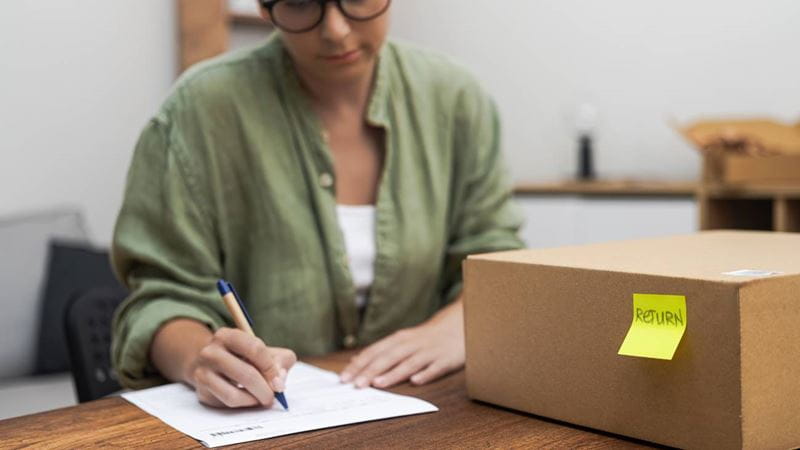
This article is for general guidance only and is not financial or professional advice. Any links are for your own information, and do not constitute any form of recommendation by Saga. You should not solely rely on this information to make any decisions, and consider seeking independent professional advice. All figures and information in this article are correct at the time of publishing, but laws, entitlements, tax treatments and allowances may change in the future.
Christmas is a time of sharing and giving… which can sometimes mean unwanted presents that you’d like to return.
If so, you’re not alone. Around three in five adults admit to having received an unwanted Christmas present, according to comparison website Finder.com. The average amount spent per person on unwanted gifts is £41, and these are most likely to include soap, bath bombs and moisturisers, novelty items and household gadgets.
The good news is that if you’ve received a gift that’s not quite to your taste, you have options.
For any gift you want to return or pass on, check the item isn’t faulty and has not been used or altered in any way. For example, check that a book hasn’t been inscribed with a personal message by the gifter. Also, check for any hidden extras. You don’t want to regift something, only to find out there was an unexpected extra inside such as a ten-pound note.
If you don’t like an item, this would be considered a “change of mind”. If the item was bought in-store, it will depend on the retailer’s terms and conditions as to whether they will provide any exchange or gift card.
There is no obligation for a retailer to refund or exchange any items bought in store just because you don’t like them. The exception is if the retailer’s terms and conditions say that they will refund or exchange with a receipt for change of mind or unwanted items – this counts as a contractual agreement.
But the rights generally remain with the purchaser if you have a receipt that’s not a gift receipt. This means that if the giver has provided the receipt, you’ll need to check with the retailer as to whether they will still refund. It will usually be refunded using the method used to pay, which means that any refund could go back onto the bank card the buyer used. Some stores will insist that the card-holder needs to be present.
You will probably need the receipt or gift receipt to return anything, but it can be worth asking if you don’t – though stores are generally becoming less lenient about accepting returns with no receipt. If the store will accept a return without a receipt, then it will refund you the cheapest price at which the item was sold.
If the giver has enclosed a gift receipt, that’s the best-case scenario. it means the retailer accepts returns and the gifter need never know. It will depend on the retailer’s terms and conditions as to how this is refunded. It’s likely that they will give you a credit note or gift card – make sure you check the expiry date if you get one.
When returning any item – whether clothes, beauty gifts or books – the item will need to be in perfect condition in the original packaging, so the retailer is able to sell it on.
For items bought online and not in a physical shop, you have 14 days to tell the trader that you’ll be returning the item and 14 days after that to do so. Some retailers offer extended return periods for items bought in December.
However, you may struggle to get a refund without the necessary online receipt and the refund will go to the method used to pay for the item – likely the giver’s own card.
If you have a gift receipt or returns note for an item bought online, you’ll probably be able to get something back, without the giver needing to find out, but it may depend on the store. Marks & Spencer says if you have a gift receipt for an item bought online, you can return it to one of its stores and you'll receive a credit note. John Lewis says that if you have the returns note and label that came with the order, you can return a gift in-store and get its value refunded onto a gift card, or you can exchange it for something else.
If you return gifts via the post, the refund will usually go to the original payment card. So you’ll then need to explain to the gift-giver that you’d like to return the item.
If the item was bought from Amazon and the giver has chosen to send you a gift receipt, you can return it without them knowing. You’ll get the refund in the form of an Amazon voucher.
If you don’t have any kind of proof of purchase or returns label, you’ll struggle to return an item, so again, you’ll probably need to talk to the gift-giver.
Under the Consumer Rights Act 2015, items must:
If these don’t apply, you are entitled to a full refund if it’s within 30 days of purchase. After this time, you are entitled to a repair or replacement.
However, you will need proof of purchase. That doesn’t have to be a receipt, if you’ve got another form of proof, such as a bank statement or (possibly) an order number. The refund will usually be returned to the same card that was used to pay (unless the item was paid for with cash).
Usually, you need to return items within 28 or 30 days, though it can be less, especially for purchases in the sale or at outlet stores. Many of the large retailers, such as Marks and Spencer, John Lewis and Amazon, have extended their usual returns window for the festive period.
Items bought from Marks and Spencer between 1st November and 24th December 2024 can be returned up until 28th January 2025. After this time, the returns window reverts back to 35 days (or 14+14 days for Sale items bought online).
John Lewis allows items bought between 26th September 2024 and 24th December 2024 to be returned up until 23rd January 2025. You must have a receipt. After this time, the returns window reverts back to 30 days.
Amazon says that most items purchased between November 1 and December 25 2024 can be returned until January 31, 2025 or within 30 days of receipt (whichever is later). You’ll need the person who bought the item to arrange the return through their Amazon account.

You could sell unwanted gifts on online marketplaces such as eBay – which has recently dropped selling and postage fees – or on Facebook or Vinted.
If you choose to do this, make sure you provide a clear description. Although private sellers are not fully bound by consumer law, items must match their description, otherwise the purchaser could make a claim against you.
Check that the item is not counterfeit, research what to look for in replicas and make sure it is not subject to a recall or safety notice.
You could keep the item to regift to someone else – just make sure you make a note of who gave it to you. Or perhaps you could think creatively about how to use your unwanted gift? A mug or cup you don’t need could become a plant pots, pen holder, or a water dish for the birds. You could dye an item of clothing you don’t like, or have it altered if it’s the wrong size – or even turn it into a bag or cushion, if you’re handy with a sewing machine.
Unopened toiletries can be regifted to a charity shop or food bank. Food banks will also usually be grateful to receive any unopened non-perishable food items, like jams, chutneys or biscuits.
If you regularly get gifts you don’t want, it could be time to have a discussion with your friends and family about gift-giving. You could raise the topic tactfully by asking loved ones if they’d find it helpful to have gift ideas for you. Or if that feels a bit too direct, you could ask them for their own gift list, and see if they ask you the same thing back.
If you’d rather reduce gift-giving, and depending on what you feel comfortable with, you could ask for donations to charity instead next year, or suggest limiting gifts to one or two special presents. Or if other family members are willing, you could try a “Secret Santa” (where everyone buys a present for just one other person).


From their first savings account to their first home, find out how your gifts can make the biggest impact for your grandchildren


How to avoid common pitfalls when buying used products
